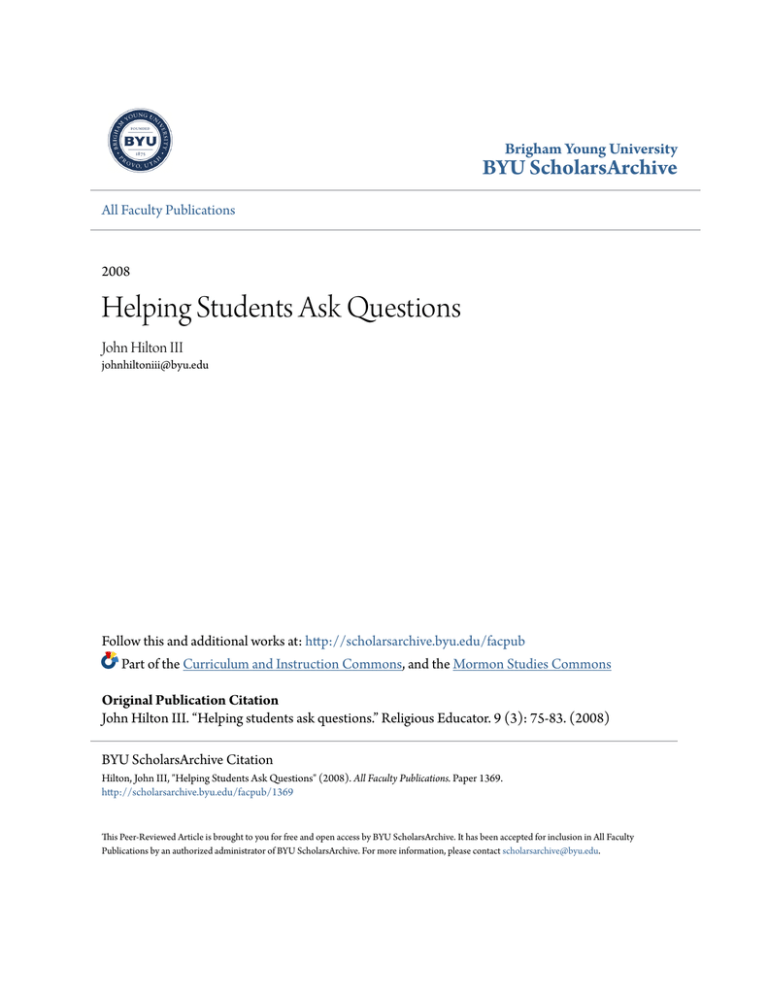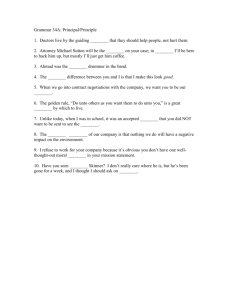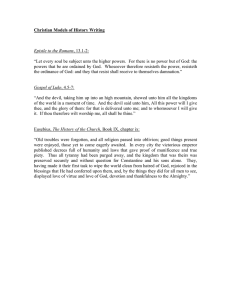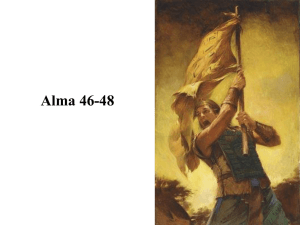Helping Students Ask Questions - BYU ScholarsArchive
advertisement

Brigham Young University BYU ScholarsArchive All Faculty Publications 2008 Helping Students Ask Questions John Hilton III johnhiltoniii@byu.edu Follow this and additional works at: http://scholarsarchive.byu.edu/facpub Part of the Curriculum and Instruction Commons, and the Mormon Studies Commons Original Publication Citation John Hilton III. “Helping students ask questions.” Religious Educator. 9 (3): 75-83. (2008) BYU ScholarsArchive Citation Hilton, John III, "Helping Students Ask Questions" (2008). All Faculty Publications. Paper 1369. http://scholarsarchive.byu.edu/facpub/1369 This Peer-Reviewed Article is brought to you for free and open access by BYU ScholarsArchive. It has been accepted for inclusion in All Faculty Publications by an authorized administrator of BYU ScholarsArchive. For more information, please contact scholarsarchive@byu.edu. 74 The Religious Educator • Vol 9 No 3 • 2008 17. Bruce C. Hafen, “Church Delegates Attend World Congress of Families,” Ensign, June 1997, 75. This concept is taught in context of society’s tolerance of homosexual behavior, and yet the majority is opposed to same-sex marriage. 18. Sterling W. Sill, “The Strait Gate,” Ensign, July 1980, 76. 19. Neal A. Maxwell, That Ye May Believe (Salt Lake City: Bookcraft, 1992), 74. 20. Boyd K. Packer, in Conference Report, October 2003, 27. 21. Boyd K. Packer, in Conference Report, April 1994, 25. 22. Dallin H. Oaks, www.lds.org under Newsroom: Same-Gender Attraction. 23. Carmack, Tolerance, 11–12. 24. John A. Widtsoe, in Conference Report, April 1941, 115. 25. Hugh B. Brown, in Conference Report, October 1959, 108. 26. M. Russell Ballard, in Conference Report, April 1989, 100–101. 27. Ann N. Madsen, “Tolerance, the Beginning of Christlike Love,” Ensign, October 1983, 29. 28. Gordon B. Hinckley, “Words of the Living Prophet,” Liahona, June 2001, 34. 29. Alexander B. Morrison, “‘No More Strangers,’” Ensign, September 2000, 20. 30. Carmack, Tolerance, 20. 31. Kimball, Teachings of Spencer W. Kimball, 236. 32. Gordon B. Hinckley, TV interview, May 12, 1995, as quoted in Sam Giles and Christie Giles, “We Don’t Want You Here,” New Era, August 1998, 10. 33. N. Eldon Tanner, “The Great Commandments,” Ensign, July 1980, 4. 34. Gordon B. Hinckley, “The BYU Experience,” in Brigham Young University 1997–98 Speeches (Provo, UT: Brigham Young University, 1997), 64. 35. Russell M. Nelson, in Conference Report, April 1991, 28–29. 36. Ballard, in Conference Report, October 2001, 45. 37. Russell M. Nelson, Ensign, November 1993, 108. This address was originally given at the 1993 Parliament of the World’s Religions, September 2, 1993. 38. Gordon B. Hinckley, in Conference Report, April 1998, 3. 39. Gordon B. Hinckley, “Charity Doth Not Behave Itself Unseemly,” Ensign, April 1988, 71. 40. Joseph Smith, Teachings of the Prophet Joseph Smith, comp. Joseph Fielding Smith (Salt Lake City: Deseret Book, 1976), 218. 41. Carmack, Tolerance, 7. Helping Students Ask Questions John Hilton III John Hilton III (HiltonJO@ldsces.org) is a Church Educational System ­coordinator in Miami, Florida. On one occasion, a class was learning about the law of chastity. The teacher had challenged the class members to commit to live the law of chastity. One young woman raised her hand and said, “What if somebody has already broken the law of chastity? Can he or she still set a goal to live it from this point on?” This important question from a student prompted the teacher to emphasize the power of repentance—something he had not planned to do. Questions from students can have a powerful effect in the teaching and learning process. In the 2007 worldwide training broadcast on teaching, Sister Julie B. Beck observed, “The more questions we can get from the learners about something, the more they are engaged in the learning. . . . But that to me is a challenge as a teacher—not so much the questions I am asking but what is happening that is helping other people to ask questions so the Holy Ghost can teach them.”1 In this same broadcast, Elder W. Rolfe Kerr, commissioner of the Church Educational System, said, “What more exciting environment in the classroom is there than [when] the children or the adults in the class are asking questions?”2 It seems that some of the best classroom discussions begin with questions from students as opposed to questions from teachers. Is there scriptural evidence of this phenomenon? Do the scriptures provide insights as to how to encourage students to ask questions? In this 76 The Religious Educator • Vol 9 No 3 • 2008 article I will explore the following: (1) scriptural evidence that powerful learning takes place when students ask questions, (2) scriptural insights on how to encourage students to ask questions, and (3) additional ways to help students ask questions. Learning Arising from Questions In the scriptures are many examples of great teachings spawned by great questions. Though the focus here is on the questions asked, consider the teachings that followed these questions: “And it came to pass that one of them said unto him: What meaneth the words which are written, and which have been taught by our fathers saying: How beautiful upon the mountains are the feet of him that bringeth good tidings?” (Mosiah 12:20–21; followed by Abinadi’s discourse to Noah and his priests). “Now the [father of King Lamoni] said unto them: What is this that ye have said concerning the Spirit of the Lord?” (Alma 22:5; followed by Aaron’s teaching of the plan of redemption). “And they came unto Alma; and . . . said unto him: . . . They have cast us out of our synagogues; . . . and we have no place to worship our God; and behold, what shall we do?” (Alma 32:5; followed by Alma’s sermon on faith). “And as he sat upon the mount of Olives, the disciples came unto him privately, saying, Tell us, when shall these things be? and what shall be the sign of thy coming, and of the end of the world?” (Matthew 24:3; followed by the Olivet discourse, comprising Matthew 24 and 25). “But he, willing to justify himself, said unto Jesus, And who is my neighbour?” (Luke 10:29; followed by the parable of the good Samaritan). These examples provide clear evidence that powerful teaching often occurs when students ask questions. Scriptural Insights about Helping Students Ask Questions Most teachers readily recognize the value of eliciting students’ questions. The difficulty lies in getting this to happen. How do teachers encourage students to ask questions? In addition to providing evidence that questions can spark effective teaching, the scriptures also give insight into how to encourage students to ask questions. The following four scriptural lessons seem particularly pertinent. Helping Students Ask Questions 77 Scriptural lesson 1: Stimulate student questions by discerning what issues may trouble them. If necessary, ask a sample question to initiate a conversation. Ammon, a master missionary and teacher, demonstrated this principle in Alma 18. While Lamoni was viewing the arms of the Lamanite robbers, Ammon was feeding Lamoni’s horses. When Ammon entered the room, “he saw that the countenance of the king was changed” (Alma 18:12). Discerning changes in students’ countenances is of key importance for teachers. As President Boyd K. Packer wrote, “The eyes of the alert teacher move constantly back and forth across the class, taking in each movement, recording each expression, responding quickly to disinterest or confusion. They read immediately a puzzled expression or sense at once when learning has taken place.”3 Although Lamoni would not speak to him, “Ammon, being filled with the Spirit of God, . . . perceived the thoughts of the king. And he said unto him: Is it because thou hast heard that I defended thy servants and thy flocks, and slew seven of their brethren with the sling and with the sword, and smote off the arms of others, in order to defend thy flocks and thy servants; behold, is it this that causeth thy marvelings?” (Alma 18:16). Because Ammon discerned the question that was in Lamoni’s heart, Lamoni felt free to speak, and he began to ask Ammon questions. This eventually opened the door for the conversion of thousands of Lamanites. Alma the Younger used this same principle to teach his wayward son, Corianton. Although we do not get to read both sides of the conversation, it is clear that Alma discerned the questions that were on his son’s mind. Alma said, “You marvel why these things should be known so long beforehand. . . . I perceive that thy mind is worried concerning the resurrection of the dead” (Alma 39:17; 40:1). Stating these unspoken questions allowed Alma to teach Corianton about the Resurrection. In practical terms, a teacher can use this principle by thinking carefully beforehand about questions students might have concerning the lesson. For example, if teaching Doctrine and Covenants 64:9–11, the teacher might be prepared to ask (if no students mention it), “Some people wonder about this question—why is it that the person who doesn’t forgive is guilty of the greater sin? What do you think about that question?” Of course, posing some questions to students that they have not asked could plant thoughts that are not productive. Teachers need to be very thoughtful about the types of questions they ask so that they are building faith and not undermining it. 78 The Religious Educator • Vol 9 No 3 • 2008 Elder Jeffrey R. Holland, in the 2007 worldwide training broadcast on teaching, gave this suggestion: “If I, the teacher, want questions from you, the student, I may have to prime the pump a little. . . . I may try to pose a question that will then take on a life of its own, and all I have to do is direct traffic in order to get the students to participate.”4 By presenting a question or two at the beginning of a discussion, students will be more likely to add questions of their own. Scriptural lesson 2: Be patient with students who seem to be asking questions in a challenging or negative manner. Respond with respect and testimony. Some teachers may be turned off by students who ask cynical questions, but these questions still provide valuable opportunities. Many of the Savior’s teachings came when He was questioned by those with an adversarial perspective. For example, the famous statement, “He that is without sin among you, let him first cast a stone at her,” was brought forth from an ill-intentioned question (John 8:7; see also Matthew 9:11; Matthew 15:2; Matthew 19:3; Matthew 22:35–36). Another scriptural episode demonstrates that teachers who patiently answer cynical questions may be able to open students’ hearts to asking more sincere questions. Amulek faced a hostile questioner in Zeezrom. In Alma 11:21 we read, “Zeezrom began to question Amulek, saying: Will ye answer me a few questions which I shall ask you?” Notice the questions and answers that follow. And Zeezrom said unto him: Thou sayest there is a true and living God? And Amulek said: Yea, there is a true and living God. Now Zeezrom said: Is there more than one God? And he answered, No. Now Zeezrom said unto him again: How knowest thou these things? And he said: An angel hath made them known unto me. And Zeezrom said again: Who is he that shall come? Is it the Son of God? And he said unto him, Yea. And Zeezrom said again: Shall he save his people in their sins? And Amulek answered and said unto him: I say unto you he shall not, for it is impossible for him to deny his word. (Alma 11:26–34) Although Zeezrom was clearly questioning Amulek in a manner that suggests he was trying to trap him, Amulek gives straightforward answers to his questions. However, he responds differently to Zeezrom’s question in verse 38: “Now Zeezrom saith again unto him: Is the Son of God the very Eternal Father?” Helping Students Ask Questions 79 Instead of giving a brief response, Amulek testifies of Jesus Christ, the Resurrection, and the Judgment. In response to this testimony, Zeezrom begins to tremble. The next time Zeezrom asks a question, his manner has changed even more: “And Zeezrom began to inquire of them diligently, that he might know more concerning the kingdom of God. And he said unto Alma: What does this mean which Amulek hath spoken concerning the resurrection of the dead, that all shall rise from the dead, both the just and the unjust, and are brought to stand before God to be judged according to their works?” (Alma 12:8). Notice the change in this once cynical questioner. Now Zeezrom really wants to learn. Teachers who treat disrespectful questioners with respect, and when appropriate, respond to questions with sincere testimony, may find that the questioners’ hearts soften and that the nature of their questions changes. Scriptural lesson 3: Some students will not directly ask the teacher questions, but will instead approach their peers. Helaman 5 contains the account of Nephi and Lehi preaching to a group of Lamanites and Nephite dissenters. Among the group was a man named Aminadab, “who was a Nephite by birth, who had once belonged to the church of God but had dissented from them” (Helaman 5:35). During Nephi’s and Lehi’s sermon, the people were encircled with a cloud of darkness. Understandably they were concerned. They turned, however, not to Nephi or Lehi, but to Aminadab, saying, “Behold, what do all these things mean, and who is it with whom these men do converse?” (Helaman 5:38). In 1 Nephi 15, after Laman and Lemuel heard their father preach about the vision of the tree of life, they approached not Lehi, but Nephi, saying, “Behold, we cannot understand the words which our father hath spoken concerning the natural branches of the olive-tree, and also concerning the Gentiles” (1 Nephi 15:7). Why did they ask Nephi instead of asking their father directly? We may never know all the reasons; nevertheless, it is significant that they turned to a sibling. These two examples illustrate that at times, students with questions will turn to a peer instead of a teacher. How can a teacher use this insight to help students? One way is to ask the class, “What are questions that some of your friends have asked you?” By doing this, the teacher will become more attuned to the questions on the minds of his or her students. Furthermore, the fact that students are being approached with questions makes it very likely that some in the class are wondering about the same issues. The teacher could ask the class, 80 The Religious Educator • Vol 9 No 3 • 2008 “How have you answered those questions?” This would give students an opportunity to practice answering questions and provide answers for their peers who have the same questions. Another way teachers can apply this principle is by giving students opportunities to answer in class questions that they will likely be asked outside of class. For example, when teaching about the Word of Wisdom, a teacher could recognize that many students will be asked a question like this, “Why does your church not allow you to drink alcohol?” After teaching the principles of the Word of Wisdom, a teacher could ask the students to role-play in pairs. One student would take the role of a missionary, and the other would be an investigator who asks, “Why can’t you drink alcohol?” Giving students this kind of opportunity to practice answering questions will strengthen their understanding and potentially increase the understanding of those who will ask questions of the students in the future. Scriptural lesson 4: Some of the most important opportunities to answer student questions come outside of class. After an institute class on eternal marriage, Maria wrote her teacher a note with a question about her sealing status in the next life, given that her parents had divorced. Because her teacher only saw Maria once a week, he provided her with some pertinent quotes to study on her own and invited her to visit with him if she had further questions. She did have additional questions, and they scheduled a meeting to talk about her concerns. Though Maria sat in many classes taught by this teacher, this one-on-one opportunity to take time to receive answers to questions outside of class may have provided the most memorable lessons she learned. Of course, good judgment must be used in answering students’ personal questions. As President Spencer W. Kimball taught seminary and institute teachers, “You may be the first line of approach. Your wise counsel could help them solve some of their problems, and you will, of course, refer them to their bishops for those solutions which lie in the bishop’s domain.”5 There are several scriptural examples of the Savior answering questions in private. In Matthew 13:1–9, the Savior taught the multitude about the parable of the sower. Afterward, “the disciples came [privately], and said unto him, Why speakest thou unto them in parables?” (Matthew 13:10). Later in this same chapter, after teaching other parables to the people, “Jesus sent the multitude away, and went into the house: and Helping Students Ask Questions 81 his disciples came unto him, saying, Declare unto us the parable of the tares of the field” (Matthew 13:36). Thus, twice in one chapter we see the Savior approached with questions “after class,” so to speak. Questions not asked in public were appropriately asked in private settings. These private conversations occurring outside of the formal instruction time proved to be most beneficial. One could say that Nicodemus also came to the Savior “outside of class time” when he came “by night” (John 3:2). In this private setting, Nicodemus asked the Savior questions that surely must have been troubling him: “How can a man be born when he is old? can he enter the second time into his mother’s womb, and be born?” (John 3:4). These examples teach us that some students will feel more comfortable asking some questions in settings outside the classroom. What can a teacher do to facilitate this kind of interaction? Perhaps the most important thing is to be approachable and to encourage continuing conversations. For example, a teacher could do the following: • Regularly have students turn in written responses to what was learned in class or in the readings, and then return these assignments with a personal response. Though most of the time the comments would be brief, this kind of communication creates an opportunity for students to ask questions, should they wish to do so. • Encourage students to feel comfortable asking questions during class. Students can also be invited to ask after class if they prefer. • Encourage students to visit during office hours if you have them. • Avoid rushing out of the classroom. Sometimes providing refreshments can facilitate students opening up. Simply being present and looking unhurried often makes it possible for students to approach the teacher. Perhaps the most important thing a teacher can do to facilitate receiving questions outside of class is, as President Howard W. Hunter said, simply to “remember that the very best teaching is one on one and often takes place out of the classroom”6 and pray for opportunities to have this kind of teaching. 82 The Religious Educator • Vol 9 No 3 • 2008 Additional Ideas to Help Students Ask Questions There are many other ways that teachers can help students ask questions. One teacher put a question box in the classroom so students could anonymously write questions that would be answered in a future class period. This helped the teacher plan class time for questions and also gave him the opportunity to prepare answers worthy of the questions. A technique that one teacher employed was to ask the students to read a specific scripture block in preparation for the next class. Students were asked to come prepared with three questions about the reading. Many students came prepared with excellent questions. Similarly, another teacher showed a CES video and asked his students to write down questions they had while watching the video. Another teacher asked his institute students to read Moses 1:1–4 slowly and carefully. He told them that they should read them over and over again and find at least ten questions they could ask from these verses. At first, the students thought that this was an overwhelming assignment—how could they find so many questions from so few verses? But as the students read the text closely, thinking about questions they could ask, their minds opened and the questions they thought up brought them deeper into the scriptures. As the students shared the questions, the teacher also allowed the students to answer each other’s questions, thus increasing their opportunity to explain, share, and testify. Perhaps one of the most important things a teacher can do to facilitate questions is to make sure students’ questions are answered at appropriate times. Nothing may be as discouraging to a potential questioner than to see a classmate’s question demeaned or unduly postponed. Conclusion Teachers can and should accept the challenge of helping students ask more questions. The scriptures demonstrate that powerful learning can transpire when students ask questions. In addition to helping students ask questions in class, teachers can encourage students to ask questions to Heavenly Father, the True Teacher. Particularly with respect to personal questions, we can invite students to “inquire of the Lord” (Alma 27:7). The brother of Jared initiated an important learning opportunity when he asked in personal prayer, “And behold, O Lord, in them there is no light; whither shall we steer?” (Ether 2:19). Helping Students Ask Questions 83 Like many of the revelations in the Doctrine and Covenants, which came in answer to a question, we can teach our students to take their questions to the Lord and receive revelation. A student’s hunger for knowledge is a driving force in the educational process. As Sister Beck explained, “The more questions we can get from the learners about something, the more they are engaged in the learning.”7 When students have questions they are almost always in a state of readiness to learn; therefore, by encouraging students to ask meaningful questions, teachers help increase their students’ motivation to learn and come unto Christ. œ Notes 1. Julie B. Beck, in Jeffrey R. Holland, “Teaching and Learning in the Church,” Ensign, June 2007, 101. 2. W. Rolfe Kerr, in Holland, “Teaching and Learning in the Church,” 102. 3. Boyd K. Packer, Teach Ye Diligently (Salt Lake City: Deseret Book, 1975), 138–39. 4. Holland, “Teaching and Learning in the Church,” 103. 5. Spencer W. Kimball, “Men of Example,” address to CES religious educators, September 12, 1975, 4. 6. Howard W. Hunter, “Eternal Investments,” address to CES religious educators, February 10, 1989, 5. 7. Beck, in Holland, “Teaching and Learning in the Church,” 101.





